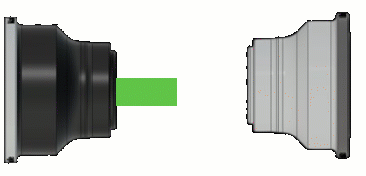Bar pull
In turning, bar pull is the process of pulling a bar of material out from the main spindle of a turning machine so that it is ready for machining. This process helps in the automation of high volume production. You can perform the bar pull on small lengths of bar, but for longer bars, your machine may need an automatic bar feeder.
In a typical bar pull operation, the machine's subspindle clamps onto the end of the bar and pulls it out of the spindle by a predetermined amount. The machine then continues its machining operation on this new section of the bar. Generally, once the machining on this section is completed, the subspindle again clamps onto the end of the bar, pulls out a new section, and the process repeats.
Typically, the main spindle stays rotating during the bar pull process. For certain machines, you may want to stop the main spindle during the bar pull process if you are using clamps on a turret to perform the bar pull instead of the sub spindle.

Illustration of a bar pull operation
Work coordinate system (WCS) for bar pull
With the Pull Mode option, you can choose to Compensate toolpaths or set a New WCS offset depending on your personal preference when viewing the NC Code. The machine motions are identical in both cases. Both options impact how the NC Code is generated to reflect that the part is now in a different position after the bar pull operation.
The Compensate toolpaths option adds the pull distance to every Z coordinate that comes after the bar pull operation. This is the simplest method to use, but it can make the NC Code harder to read for an operator. For example, if a particular spot on the part is at Z = 5 mm before the bar pull operation and the pull distance is 3 mm, then this new Z will be at 8 mm after the bar pull operation despite the point still located 5 mm from the end of the part.
The New WCS offset option requires you to set up multiple WCS on the machine. The distance between the original WCS and the WCS offset must be exactly the Pull Distance. This method is more complex as it requires accurate WCS setups on the machine but can make the NC Code easier to read for an operator. If a particular spot on the part is at Z = 6 mm, then that coordinate is still at Z = 6 mm (relative to the new WCS) after the bar pull operation.